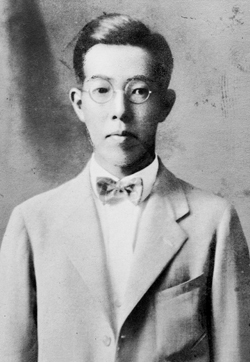THE WIND RISES
Jiro Dreams of Airplanes...
It's the strangest thing in the world if one thinks about The Wind Rises. It is an animated biopic about the creator of the Japanese Zero, the airplane that would earn infamy during World War II for the 'kamikaze' flights the Japanese pilots made in a last-ditch effort to stop the advancing American fleet from crushing the Empire of the Rising Sun. Is the film then a celebration about the man who helped create a machine that killed millions of people, another sad example of Japan's refusal to accept its role in the Second World War?
It is not so simple as that. The Wind Rises is less about Japan's failures than it is about the desire to create something beautiful, only to find that same creation used for evil.
Jiro Horikoshi dreams of taking to the skies, finding the world above so beautiful. His vision prevents him from being a pilot, but with the inspiration of Italian airplane designer Giovanni Caproni (who comes to him in dream sequences), Jiro decides to devote his life to designing his own planes.
Over the course of his life, he meets the love of his life Naoko in the Great Kanto Earthquake of 1923 and is reunited with her many years later. He also moves up quickly and methodically through the Mitsubishi Company, where Jiro is somewhat oblivious to all but his beautiful designs, even if the slowly encroaching war and Japan's growing militarism soon starts taking over the designs. The government even sponsors for Jiro and his colleagues to travel to Germany to see their innovations (and I think he might have witnessed the Kristallnacht attacks). Naoko and Jiro's love is threatened by her tuberculosis, but despite the obstacles they marry.
In the end, even though his Zeroes became instruments of death, Caproni comes to him one last time, telling him he did create something beautiful, and we see Naoko in a vision one last time as well.
What is glorious about animation is that the imagination can do so much to make things real, and The Wind Rises does so to an extraordinary and breathtaking degree. Visually the film is beautiful, so breathtakingly beautiful. The opening sequence has five minutes of no dialogue but with a series of beautiful images. Thanks to animation, we can see characters walk on wings of planes, and even the flight of Zeroes over their heads yields such beauty that I don't think instruments of war and death were never so splendidly rendered.
Even the moments which wouldn't lend themselves to being artworks become, under Miyazaki's directing, some extraordinary sequences. The earthquake sequence is so stunning that it would be impossible to imagine that the most lavish CGI would or could ever top it. The violence the Japanese see on the periphery in Germany is also something almost lovely. We even get a beautiful moment both visually and story-wise with Naoko and Jiro: their own version of 'the balcony scene'.
I am at pains to point out that there is a difference between making something visually beautiful and romanticizing the same moments. Miyazaki is not suggesting that the Kanto Earthquake or Kristallnacht are themselves beautiful, or that the actions of the Zeroes are things to think of as 'art'. Far from it: in The Wind Rises, Jiro is aware that machinery, even that which he creates in order to build something of great beauty, can be (and sadly, oftentimes is) transformed into something for destruction and death. Jiro believes that his planes are not for war or for making money, but he I think understood that the people he worked for, who in a sense were his patrons, did not share this noble vision.
I should also point out that The Wind Rises is an extremely loose biopic of Horikoshi. It is 'based on' his life, but it is not a strict biopic. Rather, I think it is Miyazaki's meditation on creating, on working to make something beautiful but how others can make things into something created with love for love into something nefarious and dark. The Wind Rises is not a celebration of Horikoshi's fighter planes or the actions of the pilots. This is not a film which attempts to hide or downplay Japan's dark past. It is, rather, a celebration of the creative process, and an acknowledgement that Japan has still, over a half-century later, still failed to come to grips with its great shame of aggression.
The trauma of its actions still sting the Japanese spirit, so much so that it finds it difficult to fully accept. The Wind Rises is miles away from a scene I remember from Neon Genesis Evangelion. In the latter, Shinji is in class and the teacher says something along the lines of, "For some reason, the United States and Japan found themselves at war". This may have been a sly dig from NGE at Japan's willful blindness. The Wind Rises, while it did trouble me because it is about the creator of the Zero, is again not a celebration of the actions. It is almost a lament for how something of beauty can be turned to something of ugliness.
If I can find one fault with The Wind Rises, it is that when they went to Germany, the church they passed by while on the train looked vaguely Russian with its onion domes. A minor flaw, granted, but there it is.
"Airplanes are beautiful dreams," Caproni tells Jiro. Oh, Miyazaki-sensei, so are your films.
So are your films...
 |
| 1903-1982 |
DECISION: A-


As you know, I am a big anime, Studio Ghibli, and Miyazaki, so I am undoubtedly going to watch the movie when it is released on Blu-Ray. I am glad to hear that the movie is quite good, and that it does not glorify the events. Also, I remember that scene from NGE.
ReplyDeleteGreat review Rick.
-James
*fan
DeleteThanks, James.
Delete